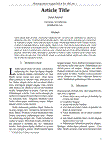| Sumario: | Japanese flounder Paralichthys olivaceus is one of the most popular marine cultured finfish in Japan, and has a good market price of2000 JPY/kg that is 2 to 3 times higher than those for yellowtail and red sea bream. Aquaculture production of Japanese flounderreached a peak of 8583 MT in 1997 and decreased linearly to 4592 in 2005 due to increasing imports of flounders. Unlike othermarine finfish species that have been produced with floating net cages, land-based culture tanks with running seawater(flow-through) are the prevalent culture system for flounder aquaculture accounting for 75% of production area in 2005. Severalmanufacturers produce commercial dry pellets for grow-out, however, considerable amount of raw fish has still been supplied aswhole or moist pellets. This paper describes the present status of commercial production of Japanese flounder in Japan, and alsoprovides up-to-date information on the nutritional availability of dietary protein, lipids, and carbohydrates for grow-out of Japaneseflounder.
|
|---|
